وكان ماويس (موجا) (Maues) أول ملك في الهند (القرن الأول قبل الميلاد) وهو من أسس حكم ساكا في قندهار وتمدد تدريجيًا على مناطق شمال غرب الهند. وانتهى حكم السكيثيين مع آخر مزربان غربي رودراسيمها الثالث (Rudrasimha III) في 395 ميلادي.
لعب غزو الهند بواسطة قبائل السكيثيين من آسيا الوسطى، غالبًا ما يشار إليه بالغزو الهندي السكيثييني، دورًا مهمًا في تاريخ جنوب آسيا وفي البلدان المجاورة. وفي الواقع، فإن الحرب بين الهند والسكيثيين هي مجرد فصل في الأحداث الناجمة عن هروب بدو شعب آسيا الوسطى من الصراع مع قبائل مثل كيونغنو في القرن الثاني الميلادي، والتي استمر أثرها على باختر وكابل وفرثيا والهند بعيدة عن روما في الغرب.
هناك ادعاء بأن المؤرخين الرومان بما فيهم آريانوس وكلاوديوس بطليموس ذكروا أن شعب ساكاس القديمة ("ساكا") كانوا في الأصل رُّحّل.[1] ومع ذلك، فإن إيطالو رونكا (Italo Ronca) في دراسته التفصيلية لبطليموس الفصل السادس، كان يرى أن عبارة: "أرض ساكاي تنتمي إلى البدو، إنهم لا يملكون مدنًا ولكن يعيشون في الغابات والكهوف" زائفة.[2]
الحواشي
- بطليموس vi, xiii (1932), p. 143.
- Ronca (1971), pp. 39, 102, 108.
معرض صور
المراجع
- Bailey, H. W. 1958. "Languages of the Saka." Handbuch der Orientalistik, I. Abt., 4. Bd., I. Absch., Leiden-Köln. 1958.
- Faccenna D., "Sculptures from the sacred area of Butkara I", Istituto Poligrafico Dello Stato, Libreria Dello Stato, Rome, 1964.
- Harmatta, János, ed., 1994. History of civilizations of Central Asia, Volume II. The development of sedentary and nomadic civilizations: 700 B.C. to A.D. 250. Paris, UNESCO Publishing.
- Hill, John E. 2004. The Peoples of the West from the Weilue 魏略 by Yu Huan 魚豢: A Third Century Chinese Account Composed between 239 and 265 CE. Draft annotated English translation. [1]
- Hill, John E. (2009) Through the Jade Gate to Rome: A Study of the Silk Routes during the Later Han Dynasty, 1st to 2nd Centuries CE. BookSurge, Charleston, South Carolina. .
- Hulsewé, A. F. P. and Loewe, M. A. N. 1979. China in Central Asia: The Early Stage 125 BC – AD 23: an annotated translation of chapters 61 and 96 of the History of the Former Han Dynasty. E. J. Brill, Leiden.
- Huet, Gerard (2010) "Heritage du Sanskrit Dictionnaire, Sanskrit-Francais," p. 128. [2]
- Litvinsky, B. A., ed., 1996. History of civilizations of Central Asia, Volume III. The crossroads of civilizations: A.D. 250 to 750. Paris, UNESCO Publishing.
- Liu, Xinru 2001 "Migration and Settlement of the Yuezhi-Kushan: Interaction and Interdependence of Nomadic and Sedentary Societies." Journal of World History, Volume 12, No. 2, Fall 2001. University of Hawaii Press, pp 261–292. [3].
- Bulletin of the Asia Institute: The Archaeology and Art of Central Asia. Studies From the Former Soviet Union. New Series. Edited by B. A. Litvinskii and Carol Altman Bromberg. Translation directed by Mary Fleming Zirin. Vol. 8, (1994), pp 37–46.
- Millward, James A. (2007). Eurasian Crossroads: A History of Xinjiang. Columbia University Press, New York. .
- Pulleyblank, Edwin G. 1970. "The Wu-sun and Sakas and the Yüeh-chih Migration." Bulletin of the School of Oriental and African Studies 33 (1970), pp 154–160.
- بطليموس (1932). The Geography. Translated and edited by Edward Luther Stevenson. 1991 unabridged reproduction. Dover Publications, Mineola, N. Y. (pbk)
- Puri, B. N. 1994. "The Sakas and Indo-Parthians." In: History of civilizations of Central Asia, Volume II. The development of sedentary and nomadic civilizations: 700 B.C. to A.D. 250. Harmatta, János, ed., 1994. Paris: UNESCO Publishing, pp 191–207.
- Ronca, Italo (1971). Ptolemaios Geographie 6,9–21. Ostrian und Zentralasien, Teil I. IsMEO — ROM.
- Watson, Burton. Trans. 1993. Records of the Grand Historian of China: Han Dynasty II (Revised Edition). Translated from the Shih chi of Ssu-ma Ch'ien. Chapter 123: The Account of Ta-yüan. Columbia University Press.
- Wilcox, Peter and Angus McBride (1986). Rome's Enemies (3): Parthians and Sassanid Persians (Men-at-Arms). Osprey Publishing; illustrated edition. .
- Yu, Taishan. 1998. A Study of Saka History. Sino-Platonic Papers No. 80. July, 1998. Dept. of Asian and Middle Eastern Studies, University of Pennsylvania.
- Yu, Taishan. 2000. A Hypothesis about the Source of the Sai Tribes. Sino-Platonic Papers No. 106. September, 2000. Dept. of Asian and Middle Eastern Studies, University of Pennsylvania.
- Political History of Ancient India, 1996, H. C. Raychaudhury
- Hindu Polity, A Constitutional history of India in Hindu Times, 1978, K. P. Jayswal
- Geographical Data in Early Puranas, 1972, M. R. Singh
- India and Central Asia, 1955, P. C. Bagchi
- Geography of Puranas, 1973, S. M. Ali
- Greeks in Bactria and India, W. W. Tarn
- Early History of North India, S. Chattopadhyava
- Sakas in Ancient India, S. Chattopadhyava
- Development of Kharoshthi script, C. C. Dasgupta
- Ancient India, 1956, R. K. Mukerjee
- Ancient India, Vol III, T. L. Shah
- Hellenism in Ancient India, G. N. Banerjee
- Manu and Yajnavalkya, K. P. Jayswal
- Anabaseeos Alexanddrou, Arrian
- Mathura Lion Capital Inscriptions
- Corpus Inscriptionium Indicarum, Vol II, Part I, S. Konow
وصلات خارجية
- "Indo-Scythian dynasties", R. C. Senior
- Coins of the Indo-Scythians
- Burner relief
- History of Greco-India



